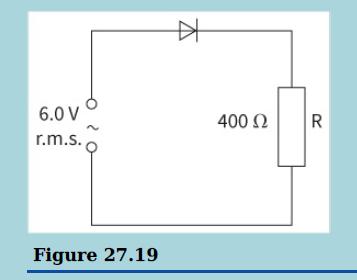A sinusoidal voltage of 6.0 V r.m.s. and frequency 50 Hz is connected to a diode and
Question:
A sinusoidal voltage of 6.0 V r.m.s. and frequency 50 Hz is connected to a diode and a resistor R of resistance 400 Ω as shown in the diagram.

a. Sketch a graph showing the variation with time of both the supply waveform (use a dotted line) and the voltage across R (use a solid line). Put numerical scales on both the voltage and time axes.
b. An uncharged capacitor C is connected across R. When the 6.0 V r.m.s. supply is switched on, the capacitor charges fully during the first quarter of a cycle. You may assume that the p.d. across the diode is zero when it conducts. For the next three-quarters of the first cycle, the diode stops conducting and the p.d. across R falls to one-half of the peak value. During this time the mean p.d. across R is 5.7 V.
For the last three-quarters of the first cycle, calculate:
i. The time taken
ii. The mean current in R
iii. The charge flowing through R
iv. The capacitance of C.
c. Explain why the diode stops conducting during part of each cycle in part b.
Step by Step Answer:

Cambridge International AS And A Level Physics Coursebook
ISBN: 9781108859035
3rd Edition
Authors: David Sang, Graham Jones, Gurinder Chadha, Richard Woodside





